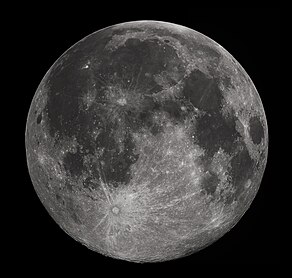Moon
This article is about Earth's natural satellite. For moons in general, see Natural satellite. For other uses, see Moon (disambiguation).
The Moon (in Greek: σελήνη Selene, in Latin:Luna) is Earth's only natural satellite. It is one of the largest natural satellites in the Solar System, and, among planetary satellites, the largest relative to the size of the planet it orbits (its primary). It is the second-densestsatellite among those whose densities are known (after Jupiter's satellite Io).
The Moon is thought to have formed approximately 4.5 billion years ago, not long after Earth. There are several hypotheses for its origin; the most widely accepted explanation is that the Moon formed from the debris left over after a giant impact between Earth and a Mars-sized body called Theia.
The Moon is in synchronous rotation with Earth, always showing the same face with itsnear side marked by dark volcanic maria that fill between the bright ancient crustal highlands and the prominent impact craters. It is the second-brightest regularly visiblecelestial object in Earth's sky after the Sun, as measured by illuminance on Earth's surface. Although it can appear a very bright white, its surface is actually dark, with a reflectancejust slightly higher than that of worn asphalt. Its prominence in the sky and its regular cycle of phases have, since ancient times, made the Moon an important cultural influence onlanguage, calendars, art, and mythology.
The Moon's gravitational influence produces the ocean tides, body tides, and the slight lengthening of the day. The Moon's current orbital distance is about thirty times the diameter of Earth, causing it to have anapparent size in the sky almost the same as that of the Sun, with the result that the Moon covers the Sun nearly precisely in total solar eclipse. This matching of apparent visual size is a coincidence. The Moon's linear distance from Earth is currently increasing at a rate of 3.82 ± 0.07 centimetres (1.504 ± 0.028 in) per year, but this rate is not constant.
The Soviet Union's Luna programme was the first to reach the Moon with unmanned spacecraft in 1959; the United States' NASAApollo program achieved the only manned missions to date, beginning with the first manned lunar orbiting mission by Apollo 8 in 1968, and six manned lunar landings between 1969 and 1972, with the first being Apollo 11. These missions returned over 380 kg of lunar rocks, which have been used to develop ageological understanding of the Moon's origin, the formation of its internal structure, and its subsequent history. After the Apollo 17 mission in 1972, the Moon has been visited only by unmanned spacecraft.

No comments:
Post a Comment